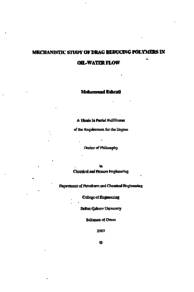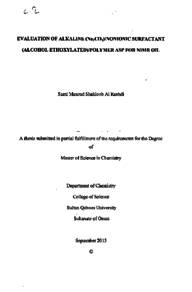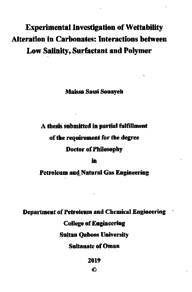Document
Mechanistic study of drag reducing polymers in oil-water flow /|cMohammad Eshrati.
Publisher
Sultan Qaboos University
Gregorian
2017
Language
English
English abstract
The Mechanistic Study of Drag Reducing Polymers in Oil-Water Flow was carried out in a horizontal, acrylic pipe with internal diameters of 30.6 mm. The working fluids were tap water and mineral-based hydraulic oil (Shell Tellus S2 V 15), with viscosity and density at 25 °C of 24 CP and 872 kg/mo, respectively. The study targeted dispersed oil water flow conditions of mixture velocities in the range 0.8. - 1.5 m/s and oil volume fractions 0.1, 0.3, 0.5 and 0.7. Master solutions of water-soluble DRPs with a concentration of 1000 ppm were used, The DRPs are high molecular-weight polyacrylamide-based polymers with different molecular weights, charge densities and side groups. The side groups are 2-acryamideo-2-methylpropane sulfonic acid (ATBS) (sulfonated polymers), N,N,N-trimethyl aminoethyl chloride acrylate (cationic polymers) and acrylic acids (partially hydrolyzed polymers). The differences in molecular weight, side groups and charge densities give rise to differences in hydrodynamic volume, chain flexibility and flow-induced polymer-polymer interactions. Polymer hydrodynamic volume is indicated by the intrinsic viscosity, while the viscoelastic properties of polymer solutions are indicated by the theological measurement of normal forces. The flow pattern map of the two-phase flow was first produced, from which the mixture-velocity/oil fraction combinations were chosen to have a dispersed flow regime. Once prepared, the polymer master solution is injected at different flow rates to achieve DRP concentrations between 5 and 40 ppm in the test section. The presence of two-polymer mixture in the master solution was also investigated to check whether synergism (or lack of it) can be obtained with regard to the overall drag reduction. Generally, drag reduction sharply increased with the increase in polymer concentration reaching a plateau value above 20 ppm. It also increased with the increase in the mixture velocities and the decrease in the input oil volume fraction. Polymer parameters that enhance the formation of flow-induced associations were found to be crucial factors that affect the effectiveness of the DRP. These parameters are the increase in molecular weight, hydrodynamic volume, concentration and polymer elasiticity. On the other hand, the size, nature and density of the side groups on the polymer backbone had mixed effects of drag reduction. These three polymer parameters might have conflicting effects on the polymer-polymer interactions. Large ATBS groups might induce higher chain rigidity that counteracts the formation of polymer-polymer associations especially at high charge densities. On the other hand, the N,N,N-trimethyl aminoethyl chloride acrylate and acrylic acid groups give the polymer chain larger hydrodynamic volume without compromising chain flexibility and polymer polymer interactions. The drag reduction of low molecular-weight polymers can be enhanced by mixing them with a high molecular-weight one. Universal drag reduction curves initially suggested by Virk et al., (1967) were used to fit the drag reduction data for the different polymer families used in this study. These curves revealed that the differences between the three polymer families with regard to their performance as DRPs cannot be attributed to polymer solubility. Friction factor correlations before and after polymer injection were also developed, and their predictions of the pressure gradients and drag reduction were satisfactory. These are pioneering models that incorporate polymer parameters such as molecular weight.
Member of
Resource URL
Arabic abstract
تم في هذا البحث دراسة آلية عمل البوليمر المقلل أثناء تدفق الزيت و الماء باستخدام أنبوب أكرليكي ذو قطر يبلغ ۳۰٫6 mm بوضعية أفقية. السوائل التي تم استخدامها في ماء الصنبور و زيت هيدروليكي (15 Shell Tellus S2v) ذي لزوجة و كثافة تبلغان ۲۶ cP و ۸۷۲ kg / m3 على التوالي. ركزت الدراسة على الحالات التي يكون فيها سريان الزيت والماء انغماسي في مدى سرعة تتراوح بين ۰٫۸-۱٫۵ m / s و نسبة زيت بلغت ۱۰, ۳۰, ۵۰ و ۷۰% وكان تركيز البوليمر في المحاليل الرئيسية المستخدمة هو ۱۰۰۰ ppm حيث ان البوليمر ذو كتلة جزيئية عالية وبأنواع مختلفة من حيث نوع وكثافة الشحنة والمجموعات الجانبية في التركيب الكيميائي لكل بوليمر. الفارق في الكتلة الجزيئية والمجموعات الجانبية وكثافة الشحنة كانت نتيجته الاختلاف في الحجم الهايدرودايناميكي لجزيئات البوليمر المذابة في الماء، ومرونة السلسلة وقابلية جزيئات البوليمر على الارتباط اللحظي أثناء التدفق في الأنابيب. تم في بادئ الأمر انشاء خارطة لأشكال الجريان للسائلين المستخدمين باستخدام مدى السرعة المذكور سابقا لضمان الحصول على شكل الجريان الإنغماسي. ومن ثم تم ضخ المحلول الرئيسي بمعدلات جریان مختلفة للحصول على بوليمر مقلل للاحتكاك بتركيز يتراوح بين 5 و40 ppm في الجزء المراد دراسته في الأنبوب. كما تم دراسة تأثير خلط نوعين من البوليمر في المحلول الرئيسي للتأكد فيما إذا كان في الإمكان أن ينتج نوع من التعزيز فيما يتعلق بتقليل الاحتكاك الكلي. بشكل عام، تقليل الاحتكاك ازداد بشكل كبير بزيادة تركيز البوليمر واستقر مع ارتفاع التركيز الأكثر من ۲۰ ppm. زيادة سرعة الخليط وتقليل نسبة الزيت فيه أديا أيضا إلى زيادة تقليل الاحتكاك. تم إثبات أن عوامل الزيادة في الكتلة الجزيئية والحجم الهايدرودايناميكي والتركيز وسرعة المزيج البوليمر كانت ذات تأثير كبير على فعالية البوليمر المقلل للاحتكاك. من ناحية أخرى وجد ان حجم وطبيعة وكثافة المجموعات الجانبية في تركيبة البوليمر الأساسية كان لها تأثيرات متباينة على تقليل اجار . الاحتكاك. لقد نتج في بعض الأحيان تعزيز لتقليل الاحتكاك من خلال خلط بوليمر ذي كتلة جزيئية منخفضة مع بوليمر ذي كتلة جزيئية عالي. ولد تم استخدام النتائج لهذه الدراسة في تكييف منحنيات فيرك (Virk) ونتج عن هذا ما يمكن تفسيره بأن الاختلاف بين أنواع البوليمرات الثلاث المستخدمة وتباين كفاءتها في تقليل الاحتكاك لا يمكن نسبته إلى اختلاف قابلية البوليمرات للذوبان في الماء . وأخيرا تم إيجاد علاقة رياضية لعامل الاحتكاك قبل وبعد ضخ البوليمر لتقليل الاحتكاك وكان مقدار تنبؤ هذه العلاقة بفاقد الضغط وتقليل الاحتكاك مرضيا.
Category
Theses and Dissertations



